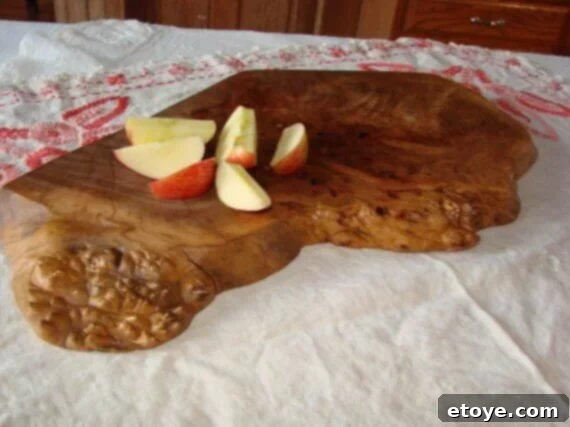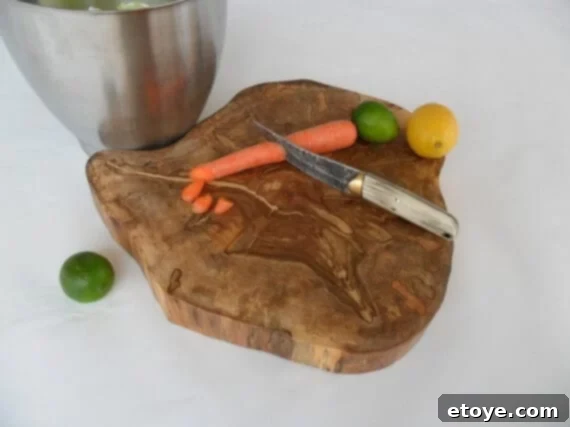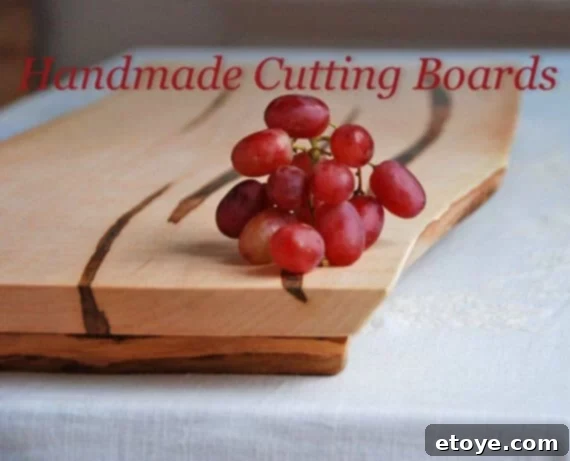Elevate Your Kitchen: The Timeless Appeal of Handcrafted Wooden Cutting Boards
In the heart of every culinary space, certain tools transcend mere utility to become cherished staples. For many, a high-quality wooden cutting board holds this esteemed position. It’s more than just a surface for chopping; it’s a foundational element of kitchen design and a testament to the art of cooking. My own kitchen proudly features a custom-made black walnut cutting board from Eric Childress, a piece so integral it feels like a permanent fixture. I meticulously measured my countertop and sent Eric the precise dimensions, and a few weeks later, a masterpiece arrived, perfectly complementing my space and enhancing my daily culinary rituals.
The journey of discovering the ideal cutting board often leads to the world of handcrafted artisans, where passion, skill, and sustainable practices converge. These aren’t just boards; they are works of art, meticulously carved and finished, offering unparalleled durability and beauty. Let’s delve into some truly gorgeous examples I’ve discovered, showcasing the incredible diversity and craftsmanship available today.
The Enduring Charm of Artisanal Woodwork: Why Handcrafted Stands Apart
Choosing a handcrafted cutting board is an investment in quality, aesthetics, and sustainability. Unlike mass-produced alternatives, artisanal boards often feature unique grain patterns, superior construction, and the personal touch of a skilled maker. They’re built to last, designed to be cherished, and frequently made from responsibly sourced or reclaimed timber, reflecting a commitment to environmental stewardship. These boards become focal points, sparking conversations and adding a warm, organic touch to any kitchen decor.
Spotlight on Unique Hand-Carved & Finished Boards
The online marketplace Etsy is a treasure trove for discovering independent artisans who pour their heart and soul into creating functional art for the kitchen. Here are some remarkable finds that exemplify the beauty and craftsmanship inherent in handmade wooden cutting boards:
Gray Works Design: Sustainable Elegance from Woodstock, NY
I recently acquired a stunning footed cutting board from Gray Works Design, based in picturesque Woodstock, NY. This piece has garnered so many compliments that I’ve transformed it into a striking display for fresh fruit, deeming it almost too beautiful to cut on! Gray Works Design is commendable for their commitment to using only locally harvested, sustainable, or salvaged wood, ensuring that each board tells a story of responsible forestry and skilled repurposing.
Salvaged Sycamore Cutting Board ($135): This particular board exemplifies the unique beauty of salvaged sycamore. Sycamore wood is known for its distinctive flecked grain, often resembling a leopard print, which adds an intriguing visual texture. Salvaged wood not only prevents waste but also often boasts a richer history and character, making each piece truly one-of-a-kind. The footed design elevates the board, making it ideal for both serving and display.
Rustic Black Walnut Footed Carving Plate ($75): Black walnut is consistently a top choice for cutting boards due to its rich, dark hues and remarkable durability. This rustic version from Gray Works Design highlights the wood’s natural beauty, often featuring captivating grain patterns. Its footed design also provides stability and makes it an excellent carving plate, catching juices and presenting food elegantly.
Buttery Hackberry Footed Platte ($115): Crafted from sustainably harvested hackberry wood, this board offers a lighter alternative to the darker walnut. Hackberry is known for its beautiful, subtle grain and impressive hardness, making it a robust choice for kitchen tasks. The “buttery” description likely refers to its smooth finish and warm, inviting tones, adding a soft contrast to your kitchen palette.
Appalachian Joinery: The Timeless Beauty of English Walnut
From Appalachian Joinery, we find a Warm Nut Brown and Smokey Gray English Walnut Cutting Board ($40). English walnut is prized for its fine grain and the captivating array of colors it can display, ranging from pale yellows to rich, smoky browns and even purplish undertones. The artistry of joinery ensures a stable and durable surface, perfect for everyday use while adding a touch of rustic sophistication to your kitchen.
Old Furnace Woodworks: Uniquely Shaped Big Leaf Maple
Old Furnace Woodworks offers a distinctive, uniquely shaped cutting board made from Big Leaf Maple ($85). Big leaf maple, native to the Pacific Northwest, is celebrated for its beautiful wavy and quilted grain patterns, which can create stunning visual effects. This board’s unusual shape makes it not only a functional cutting surface but also an eye-catching serving platter, perfect for cheeses, charcuterie, or appetizers.

Red Onion Woodworks: Extra Thick Natural Edge Beauty
Red Onion Woodworks from Philomath, Oregon, presents an Extra Thick Natural Edge Wooden Cutting Board ($108). A “natural edge” board retains the original, untouched contour of the tree’s trunk, often including bark or its natural wavy line. This style brings an organic, rustic elegance to the kitchen, highlighting the raw beauty of the wood. The extra thickness also speaks to its durability and stability, making it ideal for heavy-duty chopping.

A Burl Burst Natural Edge Serving Tray: Too Pretty to Cut On?
Consider this breathtaking Burl Burst Natural Edge Serving Tray ($84). While it’s arguably too exquisite for the rigor of knife work, its unparalleled beauty makes it an absolutely perfect cheese and bread board. Burl wood, formed by abnormal growths on trees, creates stunning, swirling grain patterns that are highly sought after for their intricate aesthetics. This piece is a true showstopper, transforming any serving occasion into an artful display.
TallyLocke: Modern Flair with Sustainable Black Walnut
TallyLocke from Portland, Oregon, brings cutting boards with a modern flair, utilizing sustainably harvested black walnut ($38). This artisan emphasizes clean lines and contemporary design, proving that eco-consciousness can go hand-in-hand with stylish kitchen essentials. The versatility and rich tones of black walnut make these boards suitable for a variety of tasks, from everyday chopping to elegant serving.
The Superiority of End-Grain Cutting Boards: A Chef’s Secret
For those serious about their knives and the longevity of their cutting boards, end-grain boards are often considered the pinnacle of quality. These boards are constructed by orienting the wood fibers vertically, so the knife edge slices *between* the fibers rather than across them. This unique construction offers several significant advantages:
- Knife-Friendly: End-grain boards are far gentler on knife edges, helping to keep them sharper for longer. The wood fibers give way slightly to the blade, preventing the edge from dulling as quickly as it would on a side-grain board.
- Self-Healing Properties: This “giving way” action also means the board itself is more resistant to scarring. The fibers tend to close back up after a cut, making the board appear “self-healing.” This contributes to a much longer lifespan compared to edge-grain boards.
- Durability: The robust construction of end-grain boards makes them exceptionally durable and less prone to warping or cracking.
- Aesthetics: The cross-section of wood grain reveals stunning geometric patterns, often resembling intricate mosaics. This makes end-grain boards incredibly attractive and adds a sophisticated touch to any kitchen.
- Hygiene: Due to their self-healing nature, end-grain boards are less likely to develop deep grooves where bacteria can harbor, making them a more hygienic choice with proper care.
Saved From a Fire offers an exemplary end-grain board using a mosaic of wood bits and ends, ranging from Ash to Zebrawood. While a little pricier due to the intensive craftsmanship and material usage, an end-grain board is an investment that truly lasts a lifetime, making it well worth the cost ($250).
Beyond the Grain: Unique Styles and Specialized Boards
The world of handcrafted cutting boards extends to wonderfully unique and specialized designs, catering to every taste and kitchen need.
Family M: Artistry in Wood-Burned Designs
For something truly unique and personalized, consider a wood-burned cutting board ($21) from Family M. While the specific wood type isn’t mentioned, the pyrographed designs add an artistic dimension, transforming a functional item into a piece of decorative art. These boards are perfect for gifting or for adding a touch of personalized charm to your own kitchen.

Aspen Custom: Durable Maple Butcher Blocks
Aspen Custom in Crossville crafts sturdy Maple cutting blocks ($135). Maple is a classic choice for butcher blocks and cutting boards due to its closed grain, hardness, and light color. Its density makes it highly resistant to knife marks and staining, providing a durable and hygienic surface. These limited-edition pieces, with only 12 left, offer both robust functionality and a sense of exclusivity.

Carolina Wood Designs: The Versatile Tiger Wood Cutting Board
I’ve long admired this exceptional Tiger Wood Cutting Board ($295) from Carolina Wood Designs. This innovative end-grain board is ingeniously double-sided, allowing you to dedicate one side for vegetables and the other for meats, promoting better kitchen hygiene. Its clever design includes handles that come apart, enabling you to easily flip the board. One side of the handles features rubber feet for superior stability, preventing any sliding during use. Tiger wood, known for its exotic striped patterns and exceptional hardness, makes this board not only incredibly functional but also a striking visual centerpiece.
Thibeaults Table: The Art of Reclaimed, Air-Dried Maple
Ann from Thibeaults Table in Canada exemplifies dedication to craft and sustainability. Her approach involves using wood that has been air-dried for an astonishing 3-4 years before it is even carved and finished in the kiln. This extended air-drying process is crucial for stabilizing the wood, preventing warping and cracking, and ensuring the ultimate durability of the finished product.
Her board #103, made from a solid piece of 2-inch thick big leaf maple, is a testament to this meticulous process. Ann shares, “The figure in that board is what I love about big leaf (western maple). It is loaded with the beautiful figures of quilt, a little bird’s eye and some spalt.” These “figures” are natural anomalies in the wood grain that create exquisite patterns: “quilt” refers to a rippled, three-dimensional effect; “bird’s eye” consists of small, circular indentations resembling tiny eyes; and “spalt” results from fungal growth that creates unique, dark lines and patterns, all highly prized by woodworkers and collectors. Ann emphasizes, “We use only reclaimed maple for our boards. No tree was cut down specifically to make our boards. Usually the tree came down because it was in the way of power lines, or came down in a storm, etc…. We have a good relationship with a number of retired tree fallers on the island. Many of them have wood that they milled themselves and then left it to air dry for a number of years.” This commitment to reclaimed wood not only results in beautiful, sustainable products but also supports a community of experienced wood handlers.
Understanding the Craft: Why Handcrafted Boards Are an Investment
If the prices of these exquisite boards seem high, it’s essential to understand the immense skill, time, and quality materials involved in their creation. As Faith from The Nearest Future illustrates with her detailed explanations of making a wooden cutting board by hand, the process is far from simple. It involves careful selection of wood, precise milling, intricate joinery (especially for end-grain designs), extensive sanding, and multiple applications of food-safe finishes.
Each step requires a craftsman’s eye for detail and years of experience. This dedication contrasts sharply with the mass-produced, often lower-quality boards found in big box stores, which may be made from cheaper woods, less durable construction, and without the same attention to environmental impact. Investing in a handcrafted board means supporting individual artisans, appreciating true craftsmanship, and acquiring a durable, beautiful piece that will serve your kitchen for generations.
Choosing Your Perfect Handcrafted Cutting Board
When selecting a wooden cutting board, consider these factors:
- Wood Type: Different woods offer varying hardness, grain patterns, and colors. Maple, walnut, cherry, and hackberry are popular choices, each with unique properties.
- Grain Style: Edge-grain boards are generally more affordable and good for lighter use. End-grain boards, while pricier, offer superior knife preservation, self-healing properties, and exceptional durability, making them ideal for heavy use.
- Size and Thickness: Consider your counter space and typical cooking needs. Thicker boards are more stable and less prone to warping.
- Intended Use: Will it be primarily for chopping, or also for serving? Footed boards and those with unique shapes can double as elegant serving platters.
- Sustainability: Look for artisans who use sustainably harvested, reclaimed, or locally sourced wood.
- Aesthetics: Choose a board that complements your kitchen’s style and brings you joy every time you see it.
Caring for Your Wooden Cutting Board: Tips for Longevity
To ensure your handcrafted wooden cutting board lasts a lifetime and remains a beautiful, hygienic surface, proper care is essential:
- Hand Wash Only: Never put a wooden cutting board in the dishwasher. The intense heat and prolonged moisture will cause the wood to warp, crack, and potentially harbor bacteria. Wash with warm, soapy water immediately after use.
- Avoid Soaking: Do not let your board sit in water. Prolonged exposure to water can lead to warping and cracking.
- Rinse and Dry Immediately: After washing, rinse thoroughly and wipe the board dry with a towel. Allow it to air dry completely on its edge or with air circulation on all sides to prevent moisture from accumulating underneath.
- Oil Regularly: Condition your board frequently with food-grade mineral oil or a beeswax/mineral oil blend. This prevents the wood from drying out, cracking, and helps repel water. Apply a generous coat, let it soak in for several hours (or overnight), then wipe off any excess. The frequency depends on use, but once a month is a good starting point for active boards.
- Sanitize Naturally: For deeper cleaning and sanitization, you can sprinkle coarse salt over the board, rub it with half a lemon, let it sit for a few minutes, then scrape off the mixture and rinse.
- Store Properly: Store your board in a dry place, either flat or on its edge, to allow for even air circulation.
Invest in Quality, Embrace Craftsmanship
The journey through the world of handcrafted wooden cutting boards reveals a rich tapestry of artistry, sustainability, and unparalleled quality. From the rich, self-healing properties of end-grain designs to the rustic charm of natural edge maple and the profound history embedded in reclaimed woods, there’s a perfect board for every kitchen and every chef. Investing in one of these beautiful, durable pieces not only elevates your culinary experience but also supports skilled artisans who are passionate about their craft. Take the time to explore these incredible makers and find a handcrafted wooden cutting board that will bring beauty, function, and a touch of timeless elegance to your home for years to come.
